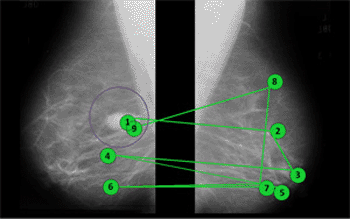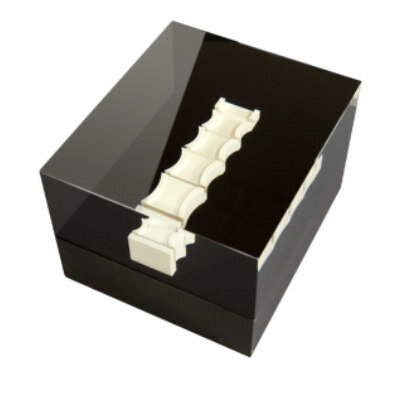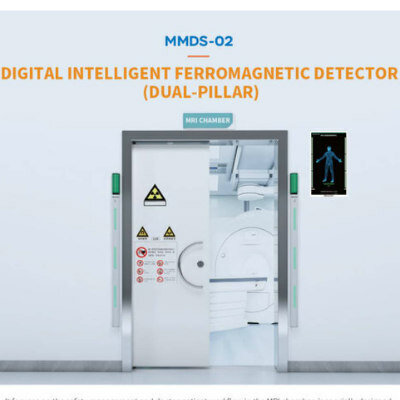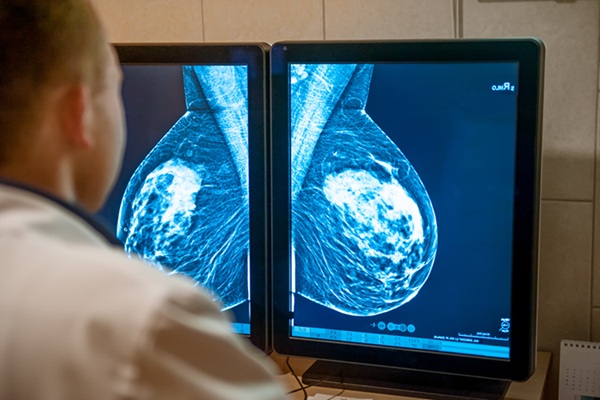Mammogram Readings Accuracy Improved with Visual Modification Technique
By MedImaging International staff writers
Posted on 08 Feb 2012
An American physician revealed that a perceptual trick she and colleagues had invented, called subtle gaze direction, might be used to improve training in reading mammography scans. An experiment showed that a novice could be subtly guided to follow an expert’s scan path across a mammogram and that this subtle prodding improved the novice’s accuracy. Posted on 08 Feb 2012
In 2011, a systematic, yet controversial, review of randomized clinical trials demonstrated that routine mammography was of little benefit to younger women at average or low risk of breast cancer. The review showed, for example, that for every 50-year-old woman whose life is prolonged by mammography, dozens are treated unnecessarily--some with damaging consequences--or treated without benefit. Hundreds are told they have breast cancer when they do not.

Image: In the study, gaze direction was used to nudge novices into following an expert radiologist’s scanpath (a simplified version of which is shown in green) as they looked at a mammogram. A potential tumor is circled (Photo courtesy of Washington University in St. Louis).
Cindy M. Grimm, PhD, associate professor of computer science and engineering in the School of Engineering & Applied Science at Washington University in St. Louis (MO, USA), was not surprised by the review, a Cochrane Review of the scientific evidence for a medical treatment. “It’s not just the mammogram that’s the problem,” she stated, “its accurately interpreting the mammogram. People aren’t good at it. Even expert radiologists aren't good at it. Results vary widely from person to person, even when people have gone through the same training.”
The research findings will be presented at the Eye Tracking Research & Application Symposium this March 2012. Dr. Grimm and her colleagues reported that the technique, should it prove effective, is widely applicable to visual search tasks. Not only might it improve the reading of mammograms and other types of medical images, such as magnetic resonance imaging (MRI) and positron emission tomography (PET) scans, but it might also be used to improve the effectiveness of airport screening and learning in virtual environments.
Dr. Grimm designed subtle gaze direction together with colleagues Reynold Bailey, PhD, then her graduate student, and Ann McNamara, PhD, then of Saint Louis University, a conference acquaintance. “I had double-majored in art and computer science as an undergraduate at the University of California, Berkeley,” Dr. Grimm said. “So I was aware that artists have all sorts of tricks for guiding viewers to look at particular areas in a painting, sometimes, in the case of narrative art, in a particular sequence. They might make an area brighter than the background, increase the contrast, or have strong edges [borders] that attract the eye. Movie producers do the same thing in postprocessing. For example, when one actor is talking and others are listening, the audience tends to watch the talker. But the producer can direct attention to a listener’s reaction instead by changing the color or brightness of that part of the image.”
Subtle gaze direction is a high-tech version of this long established craft. It works, according to Dr. Grimm, by exploiting the difference between peripheral and central (foveal) vision. “We use a small area in the central part of our retina called the fovea to see detail,” she remarked. “But foveal vision doesn’t actually cover much of our field of view. If you hold out your thumb, your foveal vision--the part of your surroundings you’re actually seeing in detail--covers about the same area as your thumbnail. We use our foveal vision to read or drive or for other detail-oriented tasks. At the same time, we are monitoring the rest of our environment with our peripheral vision, which has lower resolution but responds faster than our foveal vision. When our peripheral vision picks up a stimulus, our eyes move to focus our foveal vision on it so that we can see it clearly. During those quick eye movements, called saccades, vision is suppressed, or masked, so that the motion of the eye, the motion blur of the image and the gap in visual perception are not noticeable to the viewer. We lose an astonishing 40 minutes of vision a day to saccadic masking.”
To direct the gaze, Dr. Grimm and her colleagues changed the brightness or “warmth” of an area in the peripheral field of view to draw the novice’s focus to this region. The stimulus remained subtle, however, because the viewer’s gaze is monitored in real-time by an eye-tracking device and the modulations to the peripheral vision are terminated before the eye fixates on them. “The idea,” commented Dr. Grimm, “is to get someone to look in a particular direction while altering their experience of viewing the image as little as possible. In the case of mammograms, you want to get a learner to look at the tumor region but you don’t want to do anything that makes the tumor region look different than it does on the mammogram itself.”
Reading mammograms is a good target for computer assistance because training is time-consuming and expensive, typically requiring a four-year residency and a two-year fellowship.
In spite of new developments in technology, novices are still trained by working as an apprentice to an expert. The mammography study, led by Dr. Bailey, now an assistant professor of computer science at the Rochester Institute of Technology (New York, NY, USA), brought together the same group of scientists as the subtle gaze direction experiment.
For the study, Dr. Grimm and her colleagues utilized a database of images provided by the Mammographic Image Analysis Society that includes both images and text files that contains coordinates of abnormalities and their size. “Expert diagnostic radiologists have a particular search pattern that is not the same as that of a novice,” Dr. Grimm stated. “We don’t know exactly what they’re doing, but they tend to do a fairly broad scan and then fixate on parts of the image that have a tumor-like texture. A novice might instead attend to brighter spots in the image or fail to scan all of it.”
Dr. Bailey hired an expert radiologist at the Rochester Institute of Technology to view and mark 65 images from the database. The expert’s scanpath was recorded during this process by an eye-tracking system. During the research, subtle gaze direction was used to guide a group of novices along the expert scanpath. A control group viewed the mammograms without gaze manipulation.
Novices who were guided were considerably more accurate than the control group or a third group guided along a random path. Moreover, even though the training session was brief, the effect remained even after gaze manipulation was disabled.
Dr. Grimm noted that more research must be done to determine that more extensive training will help in the long-term. For the time being, she can think of many ways gaze manipulation could be used to improve performance on visual search tasks. “One simple use of the technology would be to make sure readers look at every part of the image. If you’re using eye tracking,” she stated, “you know where people are looking, so you can make sure they don’t skip part of the image.”
Gaze manipulation might also be used to guide tumor-recognition software. “Suppose you had a software program that was reasonably good at spotting possible tumor areas but, erring on the side of caution, flagged too many areas as suspicious. Such software might be paired with gaze direction to ensure the radiologist looked at all of the flagged areas,” Dr. Grimm remarked. “That wouldn’t necessarily be a training application; it could be a routine element of reading mammograms.”
The mammogram study is widely applicable, according to Dr. Grimm, because there are so many visual search tasks. She mentioned airport scanners, but they are just at the top of a long list. “I work with someone who identifies pollen species,” she said. “Apparently, it takes a novice a year to learn, and they spend hours and hours looking through a microscope at these pollen grains. Again, some people are good at it and others struggle for competence. Perhaps in that case, as well, gaze direction could be used to train novice pollen identifiers.”
Related Links:
Washington University in St. Louis













